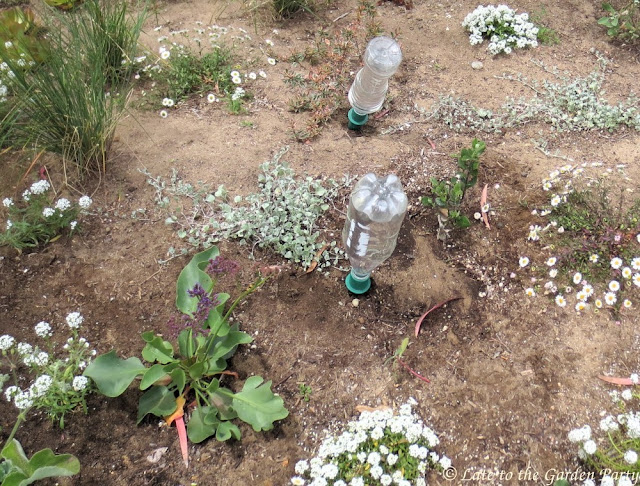In my recent
wide shots post, I mentioned that I was working on the area on the southwest end of the property alongside the street. This area is a mish-mash. The strip directly adjacent to the street is half succulent bed and half hedge. Behind that, there's a flat area and another area that slopes down from the main level of the front yard to a dry stacked wall. I've been working on that slope. It isn't as precipitous as the one at the back of our property but it still presents a challenge.
The decline of several sections of the
Ceanothus hedge planted along that slope and their subsequent removal left large areas of bare ground. This is the closest I have to a "before" photo of the area:
![]() |
| I used some of the topsoil we hauled in earlier this year to sculpt the soil (as you may be able to see in the area to the left in this photo). |
![]() |
| Thick roots left behind by the Ceanothus help to hold the soil in place and I've added rocks here and there for more support. |
Here's what the area on the left looks like after planting:
![]() |
| View from the bottom of the stone wall, looking up toward the main level of the front garden |
![]() |
| View from the opposite direction, looking down toward the succulent bed and the street |
I ordered a few plants from a native plant nursery but filled in with others that are more commonly available, including a couple that I consider "weeds" but which in this instance will at least help hold the soil while the other plants mature.
![]() |
Top row, left to right: Aeonium from cuttings with Sedum tetractinum 'Coral Reef', Festuca californica, and Gaura lindheimeri
Middle row: Abelia x grandiflora 'Confetti', Garrya elliptica 'James Roof', and Salvia 'Celestial Blue'
Bottom row: Erigeron karvinskianus, Lobularia maritima, and Limonium perezii |
Watering a slope can be difficult. I created basins around the plants where possible to allow water to collect and seep into the soil rather than running straight down. But, as these basins were more shallow than was ideal in many cases, I've also used upturned water bottles to dispense water slowly below ground level.
![]() |
| The terracotta bottle stakes work like small ollas but take up less space |
![]() |
| The plastic stakes feed water to plant roots more quickly but are more durable than the terracotta ones |
The slope's face curves from west to south. The side further to the south is less protected from the sun so I've used more succulents in that area.
![]() |
| Most of the Aeonium cuttings shown in this area were in place before the Ceanothus was removed but the plants above the Aeoniums are more recent additions |
This area is even steeper than the west side and was very difficult to plant so I made do with smaller plants that required less digging and soil preparation.
![]() |
| Clockwise from the upper left: Agave desmettiana 'Variegata', Aloe striata, California poppy seedlings, Pennisetum advena 'Rubrum', Sedum tetractinum 'Coral Reef', and Westringia 'Wynyabbie Highlight' |
Eventually, I'd like to bring in more large rocks and try to at least partially terrace the south end of this slope but that project is still a ways down on my "to do" list. My knee and I are taking a break from any further work on sloped surfaces for a time.
All material © 2012-2016 by Kris Peterson for Late to the Garden Party








